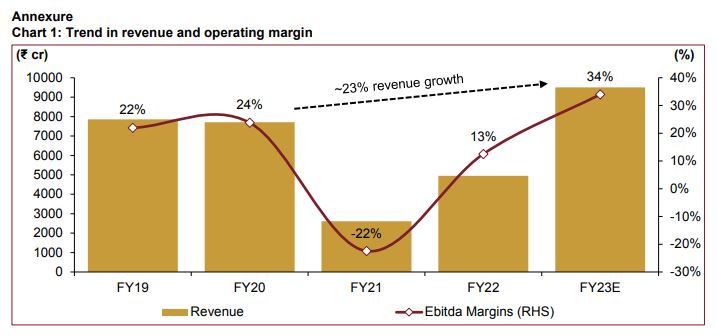Revenue to rise 23%; asset-light expansion to support credit profiles of organised cos
Higher average room rate (ARR) and occupancy will help the Indian hotel industry log a strong improvement in profitability, as represented by earnings before interest, tax, depreciation and amortisation (Ebitda) margin, to around 34% this fiscal, compared with 24% pre-pandemic (fiscal 2020).
Revenue, on its part, will increase ~23% over the pre-pandemic level, riding on a strong recovery in business travel and continued traction in leisure travel.
The strong business performance, coupled with limited capital spend, will improve the credit profiles of players.

A CRISIL Ratings analysis of hotels with an aggregate of ~40,000 rooms1 across categories indicates as much.
Says Mohit Makhija, Senior Director, CRISIL Ratings, “Leisure travel had gained traction post the Delta wave last fiscal, while business travel has started picking up steadily after a much milder Omicron wave in Jan 2022. This has been fuelling demand in the MICE (meetings, incentives, conventions and events) segment. CRISIL Ratings believes that improvement in international business travel in the second half of this fiscal will strengthen the industry performance. Occupancy will rise to ~73% this fiscal (68% in fiscal 2020), while average room rate (ARR) should increase 8-10%.”
The gap between demand and supply will aid the improvement in ARR. Developers had held back on capex amid the pandemic-induced uncertainties. While the sharp rebound in demand may spur an increase in capex, supply will take a while to catch up because of the long gestation period for setting up a greenfield hotel. That will favour existing hotels.
Meanwhile, organised players are increasing their footprint in an asset-light way. They are increasing capacity by entering into hotel management contracts for existing standalone properties, which will limit their upfront capital costs and keep leverage in control. Several standalone hotels couldn’t sail through the challenges during the last two years. Some of them have been shut down permanently, while others are exploring opportunities to collaborate withorganised players. The branded and organised players have been utilising the opportunity to expand their footprint in a market that is expected to grow well.
In the wake of the pandemic, hotels had recalibrated their costs by taking a hard look at their fixed costs and efficiencies, many of which have led to permanent savings in operating costs. The measures include reassessing employee headcount using automation and better peak-hour manpower planning. Additionally, steps such as eliminating high-cost, low-preference items from food and beverage menus and ensuring efficiency improvement to keep utility expenses in check have helped improve their cost structures.

Says Anand Kulkarni, Director, CRISIL Ratings, “Strong revenue growth and cost optimisation measures will boost profitability of organised players this fiscal. Furthermore, asset-light expansion augurs well for their balance sheets. While the credit profiles were stressed in the last two fiscals, this fiscal will bring a material improvement, with interest coverage estimated at ~4 times against ~2.6 times in fiscal 2020 and the debt to Ebitda ratio seen improving to ~1.7 times from ~3.4 times.”
That said, any economic slowdown and its impact on business travel, especially on a global scale, remains a monitorable.


